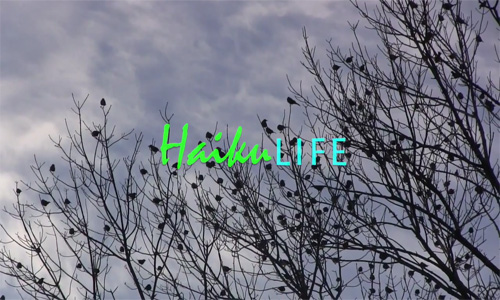I’m very pleased to have my Winter Trees videohaiku sequence included in the UK-based journal Poetry Film Live, accompanied by a generous review from my friend Marie Craven. It’s the sort of highly personal reaction I really appreciate, and from a poetry filmmaker whose work I admire. She writes about her favorite videos and why they work for her, and also zeroes in on the series’ weakest point: the text-on-screen font and effect choices. She concludes:
Overall, I found Dave’s collection a rewarding experience. I recommend it to anyone interested in poet-made videos, or in smaller, subtler and more personal approaches to the genre.
Three videos from Winter Trees in HaikuLife Festival

It’s been really gratifying to have people responding warmly to Winter Trees on Twitter and elsewhere. I sent along the link to the Haiku Foundation website for possible inclusion in their extensive bibliography of haiku-related publications, and got back a request to submit three of the videos for their 5th annual online HaikuLife Haiku Film Festival, along with some encouraging words about the sequence from Jim Kacian, whose own haiku I deeply admire.
Does this mean I’m a big poet now?
If you’re in the UK, mark your calendar for the Big Poetry Weekend, formerly known as the Swindon Poetry Festival, to be held in Swindon, UK at the Richard Jeffries Museum, October 3-7. Rather a thrill to see my ugly mug on the front page surrounded by a bunch of real poets. I’m helping to judge a film poetry competition alongside Lucy English, and will be part of a panel discussion on poetry film with her and Helen Dewbery, following a presentation by Lucy of her fantastic Book of Hours collaborative project, and followed by the awards presentation and screening. That’s all happening on Friday evening, October 4. Here’s the full programme.
If you’d like to enter the competition, by the way, there’s still time. The deadline is July 12th. Here are the guidelines.
In West Virginia
Many years ago, I was stranded in West Virginia for several days when my brother’s car broke down, and instead of going camping in the Monongahela National Forest, we got to explore the strip mall and downtown of scenic Summersville, a town famous for its speed trap and its old-time music scene. A blog post followed, and eventually a prose poem which mutated into a haibun. Now it’s been adapted into a film by Pamela Falkenberg and Jack Cochran of Outlier Moving Pictures. In West Virginia isn’t available on the open web yet because it’s still making the film festival rounds, and some festivals require films to be web virgins. But I’m pleased to report that it’s a lovely film that makes unique use of postcard-like images, and that it was selected for screening in April at the Newlyn International Short Film Festival in Cornwall.
Oops
Speaking of Newlyn: such is my neglect of this poor blog that I forgot to mention I had a video of my own screened there in 2018, Ornithology. A birder struggling through quicksand becomes a metaphor for our mostly fruitless efforts at transcendence:
Bloodshot Cartography at Cadence Video Poetry Festival
I was pleased to have a videopoem I made for a poem by Sarah J Sloat, Bloodshot Cartography, included in a couple of events in the month-long Cadence Video Poetry Festival held at Seattle’s Northwest Film Forum in April. It didn’t qualify for the main screening, but apparently they got a deluge of submissions this year… possibly because I promoted them on Moving Poems. D’oh! Regardless, it was great to be able to support such a fantastic new videopoetry festival. I’m always happy to submit films or manuscripts for a reasonable fee to organizations I believe in.
Anyway, the video combines Sarah’s evocation of travel in the tropics with a beautifully decayed old home movie, in a sort of lazy person’s homage to Stan Brakhage. The soundtrack is courtesy of the bird-sound library xeno-canto, from recordist Rodrigo Dela Rosa in the Atlantic rainforest of Brazil. The footage has been lightly edited from a single movie at the International Institute for the Conservation, Archiving and Distribution of Other People’s Memories (IICADOM):
Taking the Waters goes on tour with Poetry + Video program
A final bit of videopoetry news that I’m excited about brings us back to my Australian film-maker friend Marie Craven, who has put together an hour-long touring program of videopoems from around the world called simply Poetry + Video, and was kind enough to include an old collaboration I did with filmmaker and composer Marc Neys, with my partner Rachel Rawlins in the soundtrack: Taking the Waters. Here’s the very complete description on the website, and here’s the full program. If you’re a teacher, run a poetry reading series, or coordinate a film series in your community, get in touch with Marie — “The program is designed to be highly portable, and easily obtainable on request to screening spaces in any location. It is available to cultural organisations internationally during 2019-20.”
The world premiere screening was on May 4th in Murwillumbah, Australia, and two further screenings are on the schedule so far, one in Kathmandu and another in Muncie, Indiana.